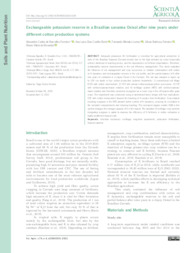Exchangeable potassium reserve in a Brazilian savanna Oxisol after nine years under different cotton production systems.
Exchangeable potassium reserve in a Brazilian savanna Oxisol after nine years under different cotton production systems.
Autoria: FERREIRA, A. C. de B.; BORIN, A. L. D. C.; LAMAS, F. M.; FERREIRA, G. B.; RESENDE, A. V. de
Resumo: Adequate potassium (K) fertilization is essential for agricultural production in soils of the Brazilian Savanna (Cerrado biome) due to the high demand by crops (especially cotton), likelihood of leaching losses, and the dependence on fertilizer importations. Therefore, sustainability requires improvements in the soil efficiency management. This study evaluated the influence of soil management and crop succession or rotation combinations with cotton on K dynamics and exchangeable reserves in the soil profile, and the partial balance of K after nine years of cultivation in a clayey Oxisol in the Cerrado. The soil was sampled in layers up to 100 cm depth in four cotton production systems treatments: 1) conventional soil tillage (CST) with cotton monoculture; 2) CST with annual cotton-soybean-cotton succession; 3) CST with cotton/soybean/maize rotation; and 4) no-tillage system (NTS) with cotton/soybean/maize rotation and Urochloa ruziziensis (ruzigrass) as a cover crop in the off-season after grain crops. The experiment was conducted using a randomized block design with four replications. CST with cotton monoculture favored the leaching of K surplus from fertilization. Crop rotation including ruzigrass in the NTS allowed better control of K dynamics, ensuring its circulation in the soil-plant compartments and reducing leaching. The increased organic matter (OM) in this system enlarges the storage capacity of K in the topsoil. The adoption of no-tillage crop systems integrating ruzigrass is viable to improve the efficiency of K fertilizers in cotton cultivation in highly weathered tropical soils.
Ano de publicação: 2022
Tipo de publicação: Artigo de periódico
Unidade: Embrapa Algodão
Observações
1 - Por padrão são exibidas publicações dos últimos 20 anos. Para encontrar publicações mais antigas, configure o filtro ano de publicação, colocando o ano a partir do qual você deseja encontrar publicações. O filtro está na coluna da esquerda na busca acima.
2 - Para ler algumas publicações da Embrapa (apenas as que estão em formato ePub), é necessário ter, no celular ou computador, um desses softwares gratuitos. Sistemas Android: Google Play Livros; IOS: iBooks; Windows e Linux: software Calibre.
Acesse outras publicações
Acesse a Base de Dados da Pesquisa Agropecuária (BDPA) para consultar o acervo completo das bibliotecas da Embrapa.

